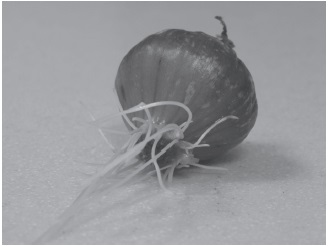Cytotoxic effect of sodium hypochlorite (NaClO) in apical cells of onion roots (Allium cepa L.)

Abstract
(NaClO) sodium hypochlorite is a highly toxic chemical compound widely used because of its disinfectant properties. One of the most commonly used plants to detect different types of genetic changes caused by chemical substances is Allium cepa L., in tests for environmental monitoring. The objective of this research was to evaluate the cytotoxic effect of sodium hypochlorite (NaClO) in apical cells of onion roots (Allium strain L.). Five sodium hypochlorite solutions were prepared at different concentrations, in addition to a control solution, with three replications for each treatment; for 3 days, the growth of the roots was measured; the apices were cut submerging them into hydrochloric acid, subsequently dyed with Aceto-Orcein and were observed under a microscope; the mitotic index (MI) was calculated and the cell anomalies were observed (chromosomal). An analysis of variance (ANOVA) and multiple range tests using the Least Significant Difference method (LSD) were performed. The results showed that there was not a statistically significant difference between the treatments (P
Keywords
Mitotic index, Metaphase, Anaphase, Anomalies
References
- Akinboro, A., K. Mohammed, S. Rathnasamy y V. Muniandy. 2011. Genotoxicity assessment of water samples from the Sungai Dua River in Pulau Pinang, Malaysia, using the Allium cepa test. Trop. Life Sci. Res. 22(2), 23-35.
- Berrocal, A.M., R.H. Blas., J. Flores y M.A. Siles. 2013. Evaluación del potencial mutagénico de biocidas (vertimec y pentacloro) sobre cebolla. Rev. Colomb. Biotecnol. 15(1), 17-27.
- Freyre, S., M. Estrada y H. Bolaños. 2009. Estudio preliminar de la citotoxicidad y la genotoxicidad de un extracto de origen vegetal conocido como palmo rosado en células meristemáticas de Allium cepa. Memorias 5(12), 12-17.
- Haq, I., S. Kumar, A. Raj, M. Lohani y G. Satyanarayana. 2017. Genotoxicity assessment of pulp and paper mill effluent before and after bacterial degradation using Allium cepa test. Chemosphere 169, 642-650. Doi: 10.1016/j.chemosphere.2016.11.101
- Hemachandra, C.K. y A. Pathiratne. 2015. Assessing toxicity of copper, cadmium and chromium levels relevant to discharge limits of industrial effluents into inland surface waters using common onion, Allium cepa bioassay. Bull. Environ. Contam. Toxicol. 94(2), 199-203. Doi: 10.1007/s00128-014-1373-8
- Hemachandra, C.K. y A. Pathiratne. 2016. Combination of physico-chemical analysis, Allium cepa test system and Oreochromis niloticus erythrocyte based comet assay/nuclear abnormalities tests for cyto-genotoxicity assessments of treated effluents discharged from textile industries. Ecotoxicol. Environ. Saf. 131, 54-64. Doi: 10.1016/j.ecoenv.2016.05.010
- Hemanth, N.K., M. Taj y S. Jagannath. 2015. Clastogenicity of sugar factory effluent using Allium assay. Res. Plant Biol. 5(6).
- Iannacone, O. y F. Alvariño. 2005. Efecto ecotoxicológico de tres metales pesados sobre el crecimiento radicular de cuatro plantas vasculares. Agric. Téc. 65(2), 198-203.
- IDEAM. 2010. Leyenda nacional de coberturas de la tierra. Metodología Corine Land Cover adaptada para Colombia escala 1:100.000. Instituto de Hidrología, Meteorología y Estudios Ambientales, Bogotá, Colombia.
- Juárez, R.P. y O.N. Lucas. 2001. Complicaciones ocasionadas por la infiltración accidental con una solución de hipoclorito de sodio. Rev. Asoc. Dental Mex. 58(5), 173-176.
- Khanna, N. y S. Sharma. 2013. Allium cepa root chromosomal aberration assay: A review. Indian J. Pharm. Biol. 1 (3), 105-119.
- Kuchy, A.H., A.A. Wani y A.N. Kamili. 2016. Cytogenetic effects of three commercially formulated pesticides on somatic and germ cells of Allium cepa. Environ. Sci. Pollut. Res. 23(7), 6895-6906. Doi: 10.1007/s11356-015-5912-6
- Llontop, L.G. y Vargas, C.D. 2016. Efecto citoreparador de Aloe vera L.“sábila” en tejidos embrionarios de Allium cepa L.“cebolla” con daño cromosómico inducido por amoxicilina. Acc Cietna 2(2), 1-10.
- Manrique, R.R., M.C. Villamizar y D.R. Quesada. 2011. Pruebas de ecotoxicidad para establecer el potencial genotóxico del hipoclorito de sodio, mediante bulbos de cebolla Allium cepa L. y semillas de lechuga Lactuca sativa L. como bioindicadores. ITECKNE 8(1), 7-14.
- Marcano, L., I. Carruyo, A. Del Campo y X. Montiel. 2004. Cytotoxicity and mode of action of maleic hydrazide in root tips of Allium cepa L. Environ. Res. 94(2), 221-226. Doi: 10.1016/S0013-9351(03)00121-X
- Marcano, L. , I. Carruyo y X. Montiel. 2001. Alteraciones citológicas inducidas por el cadmio en células meristemáticas de raíces de cebolla (Allium cepa L.). Rev. Fac. Agron. 18(4), 247-257
- Nefic, H., J. Musanovic, A. Metovic y K. Kurteshi. 2013. Chromosomal and nuclear alterations in root tip cells of Allium cepa L. induced by alprazolam. Med. Arch. 67(6), 388-392. Doi: 10.5455/medarh.2013.67.388-392
- Pandey, H., V. Kumar y B.K. Roy. 2014. Assessment of genotoxicity of some common food preservatives using Allium cepa L. as a test plant. Toxicol. Rep. 1, 300-308. Doi: 10.1016/j.toxrep.2014.06.002.
- Pathiratne, A., C.K. Hemachandra y N. De Silva. 2015. Efficacy of Allium cepa test system for screening cytotoxicity and genotoxicity of industrial effluents originated from different industrial activities. Environ. Monit. Assess. 187(12), 1-12. Doi: 10.1007/s10661-015-4954-z
- Prajitha, V. y J. Thoppil. 2016. Genotoxic and antigenotoxic potential of the aqueous leaf extracts of Amaranthus spinosus Linn. using Allium cepa assay. South Afr. J. Bot. 102, 18-25. Doi: 10.1016/j.sajb.2015.06.018
- Restrepo, R., D. Reyes, M.C. Ortiz, F.A.R. Ruiz y V.V. Kouznetsov. 2012. Aberraciones cromosomales en bulbos de cebolla Allium cepa inducidas por moléculas híbridas 4-aminoquinolínicas. Universitas Scientiarum 17(3), 253-261. Doi: 10.11144/javeriana.SC17-3.aceb
- Shrivastava, D. 2015. Cytotoxic effects of paper mill effluent on Allium cepa L. Int. J. Multidiscip. Res. Dev. 2(2), 657-661.
